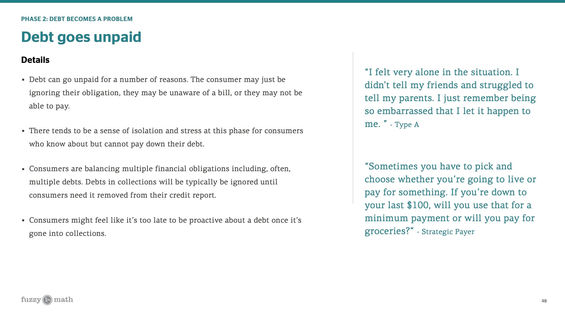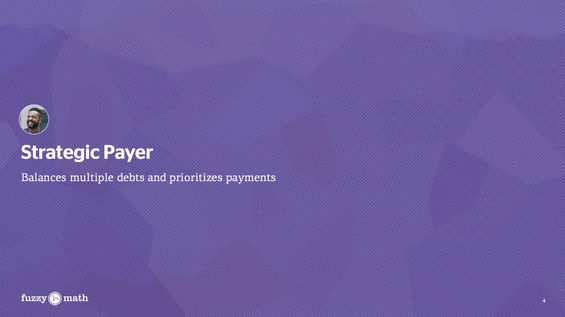UX Lead for an end-to-end overhaul of the debt collection experience
The goal of this project was to help a client in the account receivables space leapfrog their competitors by applying empathic user centered design to an industry that has long been considered an adversary to consumers.

Highlights
-
Facilitated a multi-day workshop with top executives to better understand the business and uncover assumptions of their user
-
Created a current state service blueprint
-
Surveyed of over 650 users across the U.S.
-
Conducted in depth user interviews with 22 consumers from diverse backgrounds
-
Delivered research synthesis and findings including in depth user personas
-
Designed strategic process flows and wireframes
My Role
As the project lead on this project, my role required that I facilitate workshops with the client. I also managed our relationship with the client by sending status reports and checking in with 1:1 status updates.
I managed our project plan and provided feedback to the team all while delivering on the larger, more strategic deliverables
What was the problem?
Debt collectors aren’t known for empathy or compassion. In fact, the industry has treated consumers so poorly in the past that almost every word of their communications are regulated or liable for lawsuits. Our client had a wake-up call that it would be better to shift their model than to continue down this road so they came to us to overhaul their entire user experience. They wanted to, in their words, “become the shepherd, not the hunter.”
How did we solve it?
Workshop facilitation
To kick off this project, I led a two part workshop with our client’s executive team, including the CEO. I facilitated a few activities including the User Centered Design Canvas, Empathy Mapping, we generated Design Principles, and I walked the team through something called Knowns & Unknowns. The purpose of these activities was to understand as much about their business as possible while uncovering any insights they might have on their users.
Screenshots from the remote kickoff workshop that I led.
Design Principles
Following the kickoff, we synthesized what we heard from the client to create a set of design principles. These principles would guide our decisions on design throughout the entire project.
Stakeholder Interviews & Service Blueprint
We conducted stakeholder interviews with team members across the organization from top executives to members working closely with the call center. These interviews helped us to understand how the organization would define success, but more importantly, it gave us a better sense of the assumptions they have about their users. These interviews also helped us to understand the organization’s ecosystem including all the critical touchpoints they have with consumers. We used these interviews to inform a Service Blueprint.

Competitive Landscape Analysis
Players in the accounts receivable industry — better known as debt collectors, haven’t invested much energy into understanding their users in an empathic way. There are a few new competitors in the space who have put the consumer at the center of what they do.
Our goal was to deliver a truly user centered experience for consumers dealing with debt collectors so we conducted a competitive landscape analysis to understand what others in the industry are doing. Our research included direct competitors and analogous examples from the fintech space, and we evaluated each competitor according to a set of specific project goals.
These are just a few pages from our comprehensive competitive analysis
Survey
Before diving into qualitative research, we launched a consumer survey to understand the primary pain points and experiences of consumers experiencing debt. To collect a representative sample of debtors across the United States, we aimed for 500 responses. We ultimately received 684 responses. The results of the survey helped to inform the questions we would ask in our user interviews.
These are just a few pages from our comprehensive survey findings
Consumer Interviews
Our survey provided really useful insights into what consumers were experiencing. In order to provide a narrative to the numbers, we conducted interviews with 22 individuals from diverse backgrounds across the US. These interviews provided so many insights, and they were, at times, hard to get through. Talking to people about debt can be very personal, but throughout the interviews, we made it clear that our goal was to improve this process for them. Everyone was incredibly open and appreciative of the opportunity to share about their experience.
These are just a few pages from our consumer research findings
User Personas
We created a number of personas using insights from quantitative and qualitative research. We used these personas to inform specific design decisions. The client also used these personas to help inform their outreach communications.
These are just a few pages from our user personas
Journey Map
Combining everything we knew about the existing service blueprint, the insights from quant and qual research, and the personas we’d created, we mapped out a typical consumer journey.

Conversational UI Wireframes
To translate our research into screen designs, we focused on our priority persona, the Financially Insecure Non-Payer, and built a conversational UI that would meet their specific needs.
Disclaimer: These wireframes were designed by the team UX designer with strong input from me
What was the result?
I had reservations at the beginning of the project about working with a debt collector. The user centered design process was new to the team, and we had to work harder than usual to get buy-in from our most important stakeholders. At the end of the kickoff workshop, though, one of the project's sponsors told us that he'd never thought about their users in the way that we challenged them to. Some of the stakeholders had been in the industry for 20 to 30 years, and we challenged them to put themselves in their users shoes for the first time.
One of main goals was to increase engagement with consumers by 1-2%. Their current engagement rate is about 3%. While many of our recommendations are still to be implemented, we received constant positive feedback from the team and even from the regulators who reviewed our work.
What would I do differently?
When we launched our initial round of research, we used recruiting tools that we typically use for enterprise software. Our pool of research participants was more educated and much higher paid than the consumers our client typically works with. We actually launched a second round of interviews to focus on this demographic, and I’m glad we did because we learned so much from this group. If I could do this project over, I would start the recruiting process by acknowledging any biases in our own team and hopefully involve the users we really needed earlier on.















































































